The Powell Diary did a great job in showing how all the different parts of a transcription process worked and how to get a modern english edit from old english writing published digitally. In Digital Humanities, there are many different ideas that can be applied to this
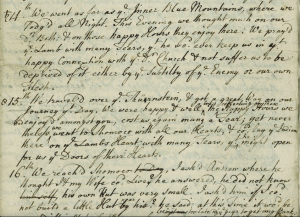
type of work. All these different topics could be covered for the assigned page of the Powell Diary, but the Mack Diary was a twenty three (23) page beast. Ryan Clifford and John Edler decided to split the Mack Diary, where John decided to take the first 12 pages, and Ryan transcribing the last 11, conquering the beast as a partnership. Once this set-up was agreed upon, John finished the transcription and then began working on tagging the material in Oxygen, a TEI coding program. Once the tags of choice were agreed upon, John started from the beginning and added codes for the computer’s recognition of the work. The tags once thought were adequate: persName and placeName,
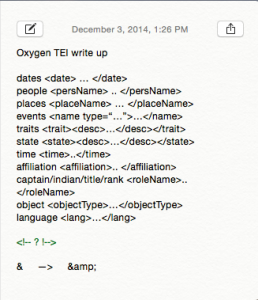
eventually did not seem to work since it was simply too hard to leave out other very valuable information. In order for this effort to satisfy Ryan’s and John’s goal, there must be enough work done for other groups to be able to use this transcription and apply other data analysis to it. With only persName and placeName, John decided to add a slue of other tags to make the digital published work represent the Diary as accurately as possible. With these extra tags, almost every line included at least one command, which just goes to show how in depth Ryan and John tagged the Mack Diary. Any questions about how to tag certain words or expressions was immediately referred to the other partner. In order to make the digital document represent the original Mack Journal, Ryan and John decided to add superscript tags, which was completed by John. Once the tagging was completed and edited by the other author, Ryan and John combined their work in John’s Oxygen file and published it as one project, portraying the work exactly as Ryan and John saw it. With Professor Jackaki’s help, the Diary was published with a very unique format that was not touched upon in the Powell Diary. The dates were in their separate column, while the body was lined up with their appropriate dates but to
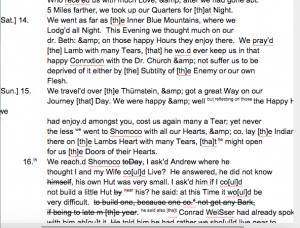
the side. The dates were listed with spaces in between each to allow the Diary’s entries to be written on the side in paragraph form. This allowed the modern publication to still follow the exact look that Martin Mack used while writing his diary, while still being able to publish the transcription digitally. Also, while the dates and body entries are being formatted, the title on the first page John transcribed will also be centered to look the same as the original. Once all this work has been completed, the Mack Diary will officially, for the first time, be transcribed into modern english and will be accessible to all of Bucknell University. This 269 year old diary, which takes place almost exactly where Bucknell sits currently, will have gone from pictures of yellow paper and scratchy black ink to an exact representation, digitally published. While not all this work was completed at the time, John wrote the
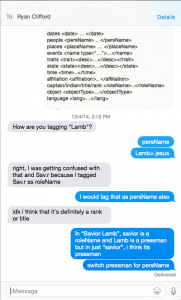
what was going to be done. This was the template, or thesis, for why the work was being done and how Ryan and John will try to represent the Diary in the publishing. When asked about why the work was being done, the abstract was referenced to format an answer. When there was a question about tagging the diary, the abstract was used to make sure the credibility of the work was not compromised. This abstract was read over by Ryan to ensure that no massive errors existed causing confusion, or the overall integrity of the journal to suffer. Once the abstract was completed and handed in, it was used to make sure the correct wording and progression of slides was used when John made the visual that was used in the presentation. Once the slideshow was completed, Ryan looked it over for revision and to become familiar with John’s work before the lightening presentation. On Monday, December 8th, Ryan and John gave a presentation for the ages, introducing the class to a phrase that will go down in history as one of the most unique and creative expressions in modern times. The presentation also was the first time the class
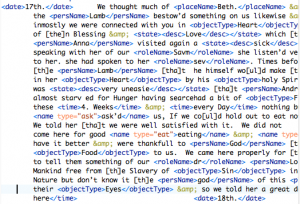
of Humanities 100-01, taught by Professor Faull, was introduced to Ryan and John’s work. The reason Ryan and John chose to transcribe the Mack Diary was not only because it was ground-breaking and never done before but also to help other possible future groups to use the work and draw connections to other similar works. This goal was actually accomplished on the same day as the speech, with Qijing Zheng and Jiayu Huang using the Mack Diary and comparing it to the Powell Diary. Their work discovered Martin Mack’s writing style referred more to a location while Joseph Powell’s work spent more time on people and their interactions. Ryan and John were
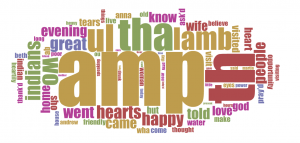
surprised with this discovery, based on the assumption that a wife means a lot to a husband and how Joseph Powell never mentions his wife in a single entry, but nonetheless, that type of data analysis was exactly what Clifford and Edler were hoping for when beginning the work. All in all, John’s first blog post does not encompass all the different forms of a digital humanities class or meet the criteria of an archive. An archive is a collection of inside views on events, or first hand accounts written as facts. Secondary sources, or sources that use primary sources to create conclusions, have bias or analytically try to find answers, are not necessary in the creation of an archive. John’s first blog post stats that archives can be made up of anything as long as it pertains to the subject. John goes on to say that digital archives could be endless but if not organized perfectly, might be too clustered to be efficient enough to work as well as a archive full of tangible documents. This remains a very fair conclusion to make and hopefully will inspire people to start using digital networks with characterization and organization.
P.S. I think in tags now. I’m very happy about it.
Links to the Mack Diary